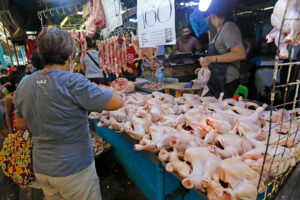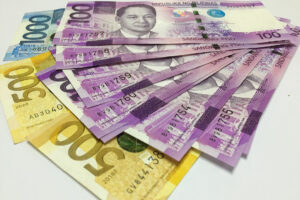March inflation likely sped up — poll

By Luisa Maria Jacinta C. Jocson, Reporter
INFLATION may have quickened for the second straight month in March, according to economists, which could make the case for the Philippine central bank to keep key rates higher for longer.
It probably rose by 3.8% last month, according to a median estimate of 17 analysts in a BusinessWorld poll, from 3.4% in February and 7.6% a year earlier.
“[Faster inflation] is likely to keep the Monetary Board ‘disciplined,’ in that it will retain a fairly hawkish rhetoric while keeping the target reverse repo rate unchanged,” Miguel Chanco, Pantheon Macroeconomics chief Emerging Asia economist, said in an e-mail.
The Bangko Sentral ng Pilipinas (BSP) is trying to balance supporting the economy through rate cuts while ensuring that these do not fan inflation or put pressure on the peso and lead to capital outflows.
It could be the second straight month that inflation picked up on a monthly basis, though still within the central bank’s 2-4% target for a fourth straight month.
BSP Governor Eli M. Remolona, Jr. and Finance Secretary and Monetary Board member Ralph G. Recto estimated 3.9% inflation for March.
The central bank has yet to release its inflation forecast for the month. The local statistics agency will release the March consumer price index (CPI) data on April 5.
Analysts said inflation might have accelerated due to higher food, utility and fuel prices.
“Inflation likely quickened for the second straight month at 3.8%, driven by higher prices of rice, meat and fruits, as well as increases in the cost of gasoline and LPG (liquefied petroleum gas),” China Bank Research said in an e-mail.
Aris D. Dacanay, HSBC economist for ASEAN (Association of Southeast Asian Nations), cited “unfavorable base effects.”
The drought has led to elevated food prices especially of rice and corn, Ruben Carlo O. Asuncion, chief economist at Union Bank of the Philippines, Inc., said in an e-mail.
In February, food inflation alone quickened to 4.8% from 3.3% in January, mainly driven by rice, which accounted for almost half of inflation during the month.
Rice inflation surged to 23.7% in February from 22.6% a month earlier and 2.2% a year ago, the fastest since 24.6% in February 2009.
Robert Dan J. Roces, chief economist at Security Bank Corp., in an e-mail cited rice supply shortages, a seasonal uptick in the prices of fish and certain food items and potential El Niño effects.
Agricultural damage from the El Niño dry spell had reached P1.75 billion as of March 14, according to a bulletin from the Department of Agriculture (DA).
More than 75,000 metric tons (MT) of farm output were lost, affecting 29,437 farmers and 31,231 hectares of farmland.
Rice and corn were the most affected crops, accounting for 64.4% (P1.13 billion) and 18.15% (P317.86 million) of the damage.
“Rice inflation is projected to hit 24% year on year and given its hefty weight in the CPI basket, will continue to push up inflation closer to the upper end of the BSP inflation target,” ING Bank N.V. Manila Senior Economist Nicholas Antonio T. Mapa said in an e-mail.
‘OFF THE TABLE’DA data showed that the average retail price of a kilo of local well-milled rice rose to P49 to P55 as of March 27 from P39 to P46 a year earlier. The price of regular milled rice went up to P50 from P34 to P40.
“Not only did retail rice prices remain at elevated levels, but rice prices increased further in March due to the ongoing risks of El Niño and the global supply crunch caused by trade curbs in India, the largest rice exporter in the world,” Mr. Dacanay added.
“Inflation accelerated mainly due to less favorable base effects, sustained high rice inflation and the upward adjustment in Manila Electric Co. (Meralco) prices,” Philippine National Bank economist Alvin Joseph A. Arogo said in an e-mail.
Higher electricity rates were observed in Meralco areas and other parts of Luzon, China Bank Research said.
The rate for a typical household rose by P0.0229 to P11.9397 per kilowatt-hour (kWh) in March due to an increase in the transmission charge for residential customers, Meralco said earlier.
Mr. Roces said global oil prices had also affected transportation and energy costs.
In March alone, pump price adjustments stood at a net increase of P2.30 a liter for gasoline, P0.65 a liter each for diesel and kerosene.
A number of oil companies also raised pump prices in the final week of March “in part due to speculations arising from the disruptions in Russia’s refineries,” Moody’s Analytics economist Sarah Tan said in an e-mail.
Analysts warned of risks that could stoke inflation in the coming months.
These include further electricity tariff hikes and proposals to raise the minimum wage, which could add to service inflation, Michael Wan, MUFG senior currency analyst for Global Markets Research, said in an e-mail.
“Inflation will reaccelerate anew before sustainably settling within the BSP’s 2-4% target in the fourth quarter because of the threats from El Niño, Middle East conflict escalation and the lagged impact of minimum wage hikes,” Mr. Arogo said.
The BSP expects inflation to average 3.6% this year. It earlier said prices could temporarily quicken in the middle of the year due to El Niño and positive base effects.
Inflation could rise further and exceed the target from April to July due to base effects, China Bank Research said.
March inflation that is more than the target could prompt the central bank to keep rates steady at its April 8 meeting, Mr. Arogo said.
“Higher inflation remains supply side-induced but given the elevated nature, it could give BSP all the reasons to retain policy rates at their elevated levels of 6.5%,” Mr. Mapa said.
The Monetary Board kept its key rate steady at a near 17-year high of 6.5% for a third-straight meeting in February. The BSP hiked borrowing costs by 450 basis points (bps) from May 2022 to October 2023.
“The central bank will have some space to cut rates gradually in the second half of 2024 once the US Federal Reserve commences its rate cut cycle, and inflation moderates further through the year,” Mr. Wan said.
Ms. Tan said rate cuts are likely “off the table” amid rising food, electricity and transportation prices.
The Monetary Board may also adopt a hawkish stance if inflation spirals out of control.
“This will prompt BSP to remain hawkish in its policy stance,” John Paolo R. Rivera, president and chief economist at Oikonomia Advisory & Research, Inc., said in a Viber message. “We might see rate cuts once inflationary pressures are well managed.”




